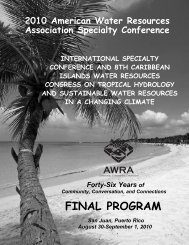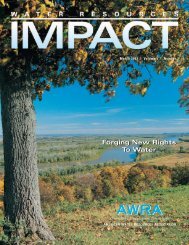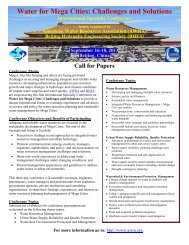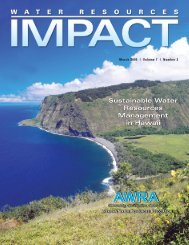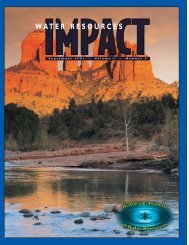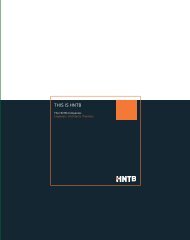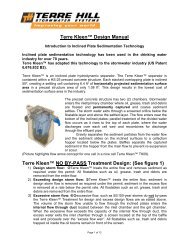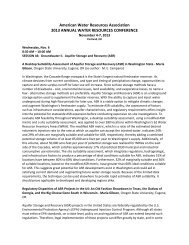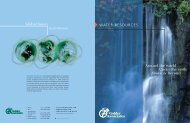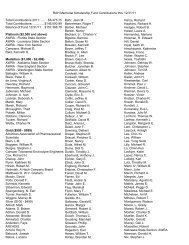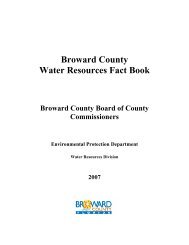N ovember 2 0 0 0 ⢠V olume 2 ⢠N umber 6 - American Water ...
N ovember 2 0 0 0 ⢠V olume 2 ⢠N umber 6 - American Water ...
N ovember 2 0 0 0 ⢠V olume 2 ⢠N umber 6 - American Water ...
Create successful ePaper yourself
Turn your PDF publications into a flip-book with our unique Google optimized e-Paper software.
NEW DIRECTIONS IN THE DEVELOPMENT OF THE WATERSHED<br />
TOOLKIT: BETTER SCIENCE MAKES BETTER POLICY<br />
Jefferson G. Edgens<br />
Never has putting together an issue of IMPACT been so<br />
fraught with problems yet so diverse in article topics.<br />
John Herring and I were slated to put this issue together<br />
almost a year ago. But as with the best of plans things<br />
develop that throws everything into a cocked hat, and<br />
this issue of IMPACT is no exception.<br />
The title of N<strong>ovember</strong>’s issue, “Directions in the Development<br />
of the <strong>Water</strong>shed Toolkit,” is a mystery. At the<br />
time of our Board meeting we conjured topics and this<br />
one came about. But John and I wracked our brains, as<br />
did too the Editor-in-Chief, to clarify what “Directions in<br />
the Development of the <strong>Water</strong>shed Toolkit” meant. No one<br />
knew.<br />
Moreover as time went by and John pursued his Fulbright<br />
Scholarship, we declared the title dead and pursued<br />
our own authors. Time sped by and John quickly<br />
turned over the entire issue to moi. With a full plate and<br />
a limited window to find writers, I made a command decision<br />
to assemble the magazine around a host of hot topics,<br />
with a common theme – Better Science Makes Better<br />
Policy. I have also taken the Editor’s perogative and developed<br />
two new sections (at least for this issue anyway):<br />
News Items and Point/Counterpoint.<br />
No one should consider the News Section as standard<br />
for all upcoming IMPACT magazines as it’s an experiment<br />
on my part and we’ll see what feedback it generates.<br />
Speaking of feedback, Clay Landry’s article in the May<br />
issue generated a response and we felt it good manners<br />
to provide the ink for the Bacchus and Samson riposte to<br />
Mr. Landry's May article or . . . Point. Of course, Mr.<br />
Landry gets equal time in his Counterpoint. Again please<br />
let the IMPACT Editorial Board know if this is something<br />
we should keep, revise, or simply throw out.<br />
For N<strong>ovember</strong>, authors write on hot topics appearing<br />
in newspapers and television programs across the country<br />
(MTBE, Blue Baby Syndrome, TMDL Developments,<br />
the Corps of Engineer Reforms and Sludge Application).<br />
Tom Randall, an environmental consultant, adapts his<br />
Chicago Tribune investigative report on sewage sludge, for<br />
our IMPACT readers. He also gives us the current state of<br />
controversy with MTBE and ground water pollution.<br />
Gretchen Randall provides us with a critique of the Corps<br />
of Engineers’ reforms. In an excellent recap of the TMDL<br />
rules, Bonner Cohen notes that in EPA’s haste to do<br />
something, the agency created additional opportunities to<br />
litigate over water quality. I’d add that additional litigation<br />
only detracts from the business of cleaning our nation’s<br />
waters. Finally, Alex Avery closes this section with<br />
his review of the science behind blue baby syndrome (a<br />
version of this article appeared in Environmental Health<br />
Perspectives).<br />
In the Features Section, two articles by Witter et al.,<br />
and Richard Halpern close the N<strong>ovember</strong> issue of<br />
IMPACT. Scott Witter et al., showcase a cutting edge idea<br />
for watershed management on the Michigan State campus,<br />
and Richard Halpern takes the profession to task<br />
with a critique of water quality modeling.<br />
His ideas take me back to my time at Michigan State<br />
University and Dr. Paul Nickel’s class on Environmental<br />
Inquiry. Dr. Nickel, borrowing from Karl Popper among<br />
others, always encouraged his students to apply critical<br />
reasoning tests and science process to our assignments.<br />
He always said, “models are representations of reality –<br />
not reality; model builders cheat and all models crash.”<br />
The last two pithy comments refer to the tendency for<br />
modelers to tweak their programs until the thing fits their<br />
desired outcome (cheating) but rarely do models comport<br />
with reality (models crash). I should also add, he always<br />
insisted we never take ourselves too seriously. A good bit<br />
of advice when we go about water quality modeling.<br />
“Directions in the Development of the <strong>Water</strong>shed<br />
Toolkit,” for what its worth, has a common theme – Better<br />
Science Makes Better Policy. Without an understanding of<br />
where we’ve failed, we’re most sure to repeat our mistakes.<br />
AUTHOR LINK<br />
E-MAIL<br />
Jefferson G. Edgens, Ph.D.<br />
130 Robinson Road<br />
Robinson Station<br />
University of Kentucky<br />
Jackson, KY 41339<br />
(606) 666-2438, x. 238<br />
Fax: (606) 666-2215<br />
E-Mail: jedgens@ca.uky.edu<br />
Dr. Edgens is the Natural Resource Policy Specialist in<br />
the Department of Forestry at the University of Kentucky.<br />
He has served on several innovative national and state<br />
committees for water and land use. His research and<br />
writing covers TMDLs, watershed management, water<br />
quality, land use, and forest policy. His writings have appeared<br />
or been cited in the Washington Post, Detroit<br />
News, The Atlanta Journal-Constitution, Louisville<br />
Courier-Journal, Macon Telegraph, Environment and Climate<br />
News and many other newspapers and journals. He<br />
has appeared on radio and television programs around<br />
the country. In addition he is an Associate Editor of<br />
<strong>Water</strong> Resources IMPACT – a publication of the <strong>American</strong><br />
<strong>Water</strong> Resources Association.<br />
❖ ❖ ❖<br />
2 • <strong>Water</strong> Resources IMPACT N<strong>ovember</strong> • 2000



